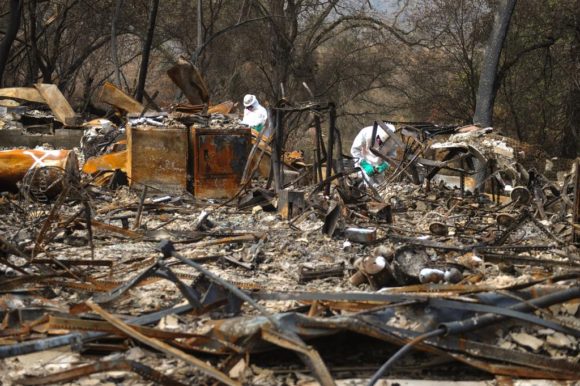Seven months after a state agency absolved PG&E Corp. of blame for a deadly 2017 wildfire, the utility giant faces the potential of billions in new legal liabilities — and it’s unclear how it would pay for them.
Despite the fact that investigators said PG&E wasn’t responsible for the Tubbs Fire that killed 22 people, a bankruptcy judge has ruled jurors should decide whether the company is to blame. The decision could expose the utility to $18 billion or more in claims, and the shares plunged 25% Monday in the biggest slump since the run up to its Chapter 11 filing in January. They were down 2.4% at 10:41 a.m. in New York.
The ruling has implications for PG&E’s bankruptcy. The company, which has a market value of about $5.6 billion, already has taken roughly $18 billion in charges for wildfires blamed on its equipment. But while its been lobbying for state legislation that would allow it to raise billions by issuing tax-free municipal bonds, the utility’s reorganization plan will now almost certainly need to include even more money for fire victims.
“No matter how you slice it, there isn’t enough financial engineering in the world for the estate to eat another $18 billion in Tubbs claims without it coming out of someone’s pocket,” said Katie Bays, a utility analyst and co-founder of Sandhill Strategy LLC.
The judge’s decision allowing lawsuits from the Tubbs fire to proceed does not interfere with its intentions to file a bankruptcy plan by Sept. 9, PG&E said in a statement. The utility intends to meet its state deadline of June 30, 2020, to exit bankruptcy, according to the statement.
In addition to floating bonds, two of the company’s shareholders, Knighthead Capital Management and Abrams Capital Management, have said they plan to raise $15 billion through a rights offering as a pool of capital the company could tap. PG&E said last week it had commitments for $12 billion.
The ruling by U.S. Bankruptcy Judge Dennis Montali is the latest bad news for the utility, which already faces separate liabilities from the deadly 2018 Camp Fire, which investigators did blame on its equipment. Last week, a court-appointed monitor said PG&E failed to properly trim trees in blaze-prone zones. And a judge forced the company to respond to a media report that PG&E deferred maintenance on equipment near the ignition point of the Camp Fire, which killed 86 people and was the deadliest in state history.
The Tubbs fire, California’s second-most deadly blaze, ripped through nearly 37,000 acres in Sonoma and Napa counties in October 2017, destroying 5,600 structures. After a 15-month investigation, the California Department of Forestry and Fire Protection determined it was started by a private electrical system — not PG&E wires.
Attorneys for the victims and insurers, however, have pushed for claims to go before jurors, saying they have evidence PG&E sparked the blaze. The lawyers also say that PG&E failed to cut power to the area despite high winds. In his decision, the judge said a limited number of fire victims and a group of insurers can pursue cases. Those claims could become test cases that offer an estimate of what PG&E’s total liability will be for the Tubbs fire.
A CalFire spokesman said the agency stands by its finding.
‘Left field’
The ruling potentially puts PG&E fate into the hands of a citizen jury at a time when the utility has been struggling to regain the public trust in the wake of the deadly blazes.
“It was a little out of left field that the judge allowed the Tubbs fire litigation to go to an outside jury,” Kit Konolige, a Bloomberg Intelligence analyst, said in an interview. “That’s a big negative surprise.”
Citigroup Inc. downgraded PG&E’s stock to “sell” and slashed its price target to $4 from $33. PG&E shares fell to $10.67, the lowest since January. The utility’s bonds also fell.
In a rare bit of good news, the bankruptcy judge sided with the utility in a separate ruling Friday that rejected requests from two groups of creditors who wanted to propose their own ways to restructure the company. Montali said opening up the bankruptcy to competing plans at this point would have led to “expensive, lengthy and uncertain disputes” that wouldn’t benefit fire victims.
–With assistance from Caleb Mutua, Steven Church and Scott Deveau.
Was this article valuable?
Here are more articles you may enjoy.


 Cars Are Getting Smarter. Why It Matters for Claims Professionals
Cars Are Getting Smarter. Why It Matters for Claims Professionals  Chinese Hacked US Telecom a Year Before Known Wireless Breaches
Chinese Hacked US Telecom a Year Before Known Wireless Breaches  Cyberattack Surge Creates Opportunity, Premium Rethink for Insurers
Cyberattack Surge Creates Opportunity, Premium Rethink for Insurers  Will Workers’ Comp Benefit from ‘Most-Favored-Nation’ Drug Pricing?
Will Workers’ Comp Benefit from ‘Most-Favored-Nation’ Drug Pricing? 